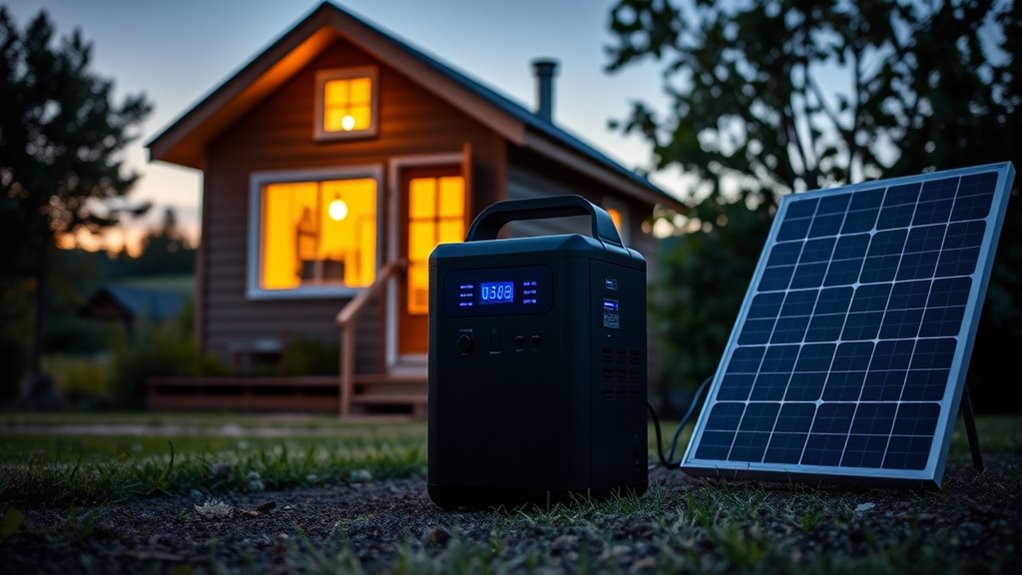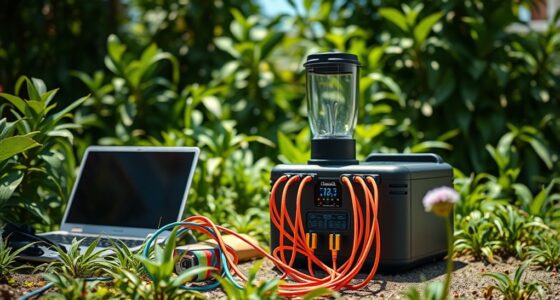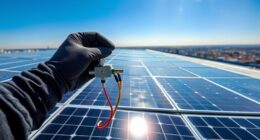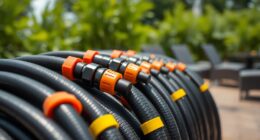To keep the lights on in your tiny home, choose a portable power station with strong solar compatibility and a large battery capacity. This setup allows you to harness solar energy directly, reducing your reliance on batteries and extending your off-grid independence. Look for models with multiple charging options and real-time monitoring to manage your energy efficiently. Stay with us to discover more tips for selecting the perfect power station for your needs.
Key Takeaways
- Choose portable power stations with high battery capacity and solar compatibility for reliable off-grid energy.
- Ensure the station offers multiple charging options, including solar, AC, USB, and 12V outlets.
- Opt for lightweight, portable units to easily move within tiny homes or outdoor settings.
- Utilize solar recharging and monitoring features to optimize energy use and ensure continuous power.
- Balance battery capacity with solar compatibility to prevent power shortages during periods without sunlight.
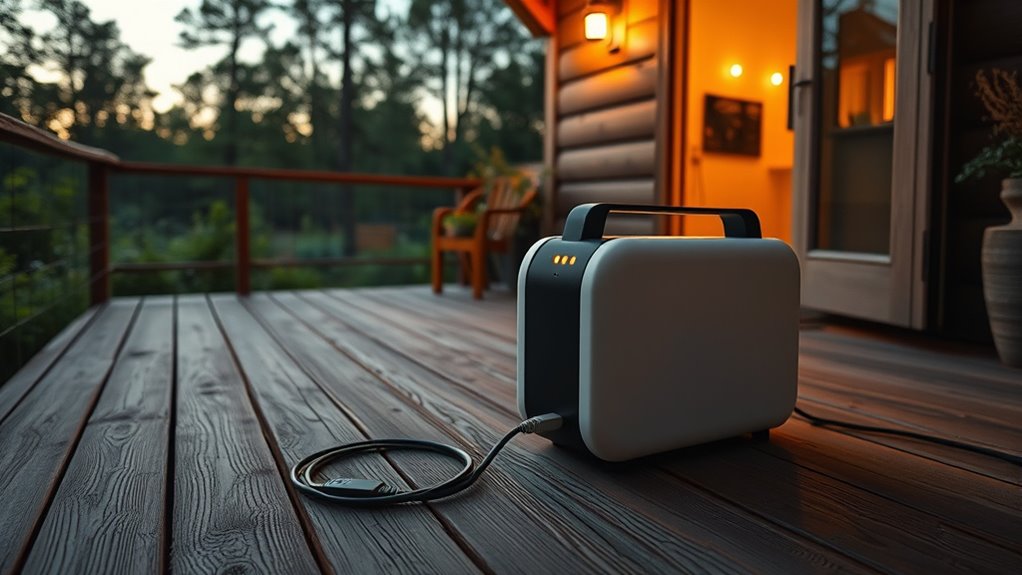
If you’re building or living in a tiny home, having a reliable power source is essential, especially when grid access isn’t always available. Portable power stations are a great solution because they provide flexibility and independence. When choosing a station, one of the most important factors to consider is solar compatibility. This feature allows you to connect solar panels directly to your power station, enabling you to harness renewable energy and stay powered up even off-grid. Solar compatibility ensures you can generate electricity during sunny days, reducing reliance on stored battery power and extending your energy independence.
Another crucial aspect is battery capacity. The size of the battery determines how much power you can store and use during periods without sunlight or when demand is high. If you plan to run multiple devices or appliances, you’ll want a power station with a higher battery capacity, so your lights, phone chargers, small appliances, and other essentials can stay operational for longer stretches. Conversely, if your needs are minimal, a smaller capacity battery might suffice, saving you money and weight. The key is to match your power station’s battery capacity with your typical energy consumption, ensuring you won’t run out of juice when you need it most.
Many portable power stations now combine solar compatibility with impressive battery capacities, giving you a versatile setup that adapts to your lifestyle. These units often include multiple charging options — AC outlets, USB ports, and even 12V car plugs — making them compatible with a wide range of devices. Their portability means you can easily move them around your tiny home or take them on outdoor adventures, providing reliable power wherever you go. With advancements in battery technology, newer models offer increased capacity without adding excessive weight, so you can carry more power without sacrificing mobility.
Additionally, the ability to recharge your power station via solar panels makes it even more efficient and eco-friendly. This integration allows you to monitor and optimize your energy use, ensuring you’re always ready for the next power need. Keep in mind that a good balance between solar compatibility and battery capacity is crucial for seamless operation. A station with excellent solar compatibility can replenish its energy quickly during sunny days, while a large battery capacity guarantees you won’t run out of power when sunlight isn’t available.
In the end, investing in a portable power station with the right combination of solar compatibility and battery capacity provides the peace of mind you need in a tiny home. It keeps your lights on, your devices charged, and your independence intact — no matter where your tiny home takes you. Understanding cybersecurity vulnerabilities associated with modern power technology can help you better protect your off-grid setup from potential threats.
Frequently Asked Questions
Can Portable Power Stations Handle High-Energy Appliances?
You wonder if portable power stations can handle high-energy appliances. Generally, they can, but it depends on their wattage capacity and whether they’re solar compatible. You’ll want a station with enough power output for your appliances. Also, consider weight considerations—larger capacity stations are usually heavier, which might affect portability. Always verify the specs to ensure your station can support your high-energy appliances safely and efficiently.
How Long Do These Power Stations Typically Last on a Full Charge?
You wonder how long portable power stations last on a full charge. Typically, their battery lifespan depends on the number of charging cycles, which can range from 500 to 1,500 cycles. After these cycles, the battery efficiency gradually declines. Usually, you can expect several years of reliable use before needing a replacement, especially if you follow the manufacturer’s recommendations for proper charging and maintenance.
Are Portable Power Stations Safe During Thunderstorms or Extreme Weather?
During thunderstorms or extreme weather, you might wonder if portable power stations are safe. They offer decent storm safety and weather resilience, especially if you follow manufacturer guidelines. Keep them away from direct water exposure and make sure they’re stored in a dry, ventilated area. While they’re generally reliable, always have backup plans for power in case of severe weather. Proper handling helps you stay safe and maintain power when you need it most.
What Maintenance Is Required to Keep Them in Optimal Condition?
Ever find your tech acting up just when you need it most? That’s why regular maintenance matters. You should regularly check your portable power station’s battery calibration to guarantee accurate charging and performance. Also, keep it free from dust and debris by gently cleaning vents and ports. This simple routine helps prevent overheating, prolongs its lifespan, and keeps your power station ready whenever you need it, rain or shine.
Can They Be Used to Charge Electric Vehicles or Larger Devices?
You can use portable power stations for electric vehicle charging or powering larger devices, but it depends on their capacity and output. Many stations support high wattage, making them suitable for charging EVs or running bigger appliances. Just ascertain the power station’s specifications match your device’s power requirements. Keep in mind, the longer the usage, the more you’ll need a station with a higher capacity to handle large device power.
Conclusion
With a portable power station, you hold the heartbeat of your tiny home in your hands, turning it into a self-sustaining oasis. Think of it as your trusty lighthouse, guiding you safely through any stormy night or power outage. It’s more than just a device—it’s the steady pulse that keeps your small space alive and vibrant. Embrace this power source, and watch your tiny home shine bright, no matter where your journey takes you.
